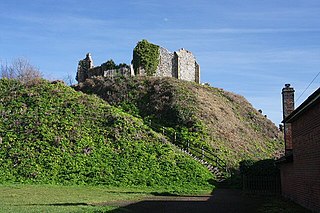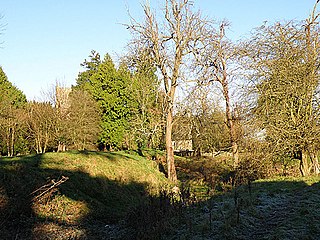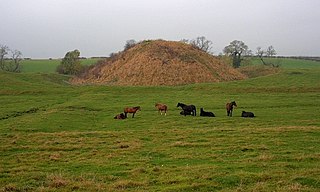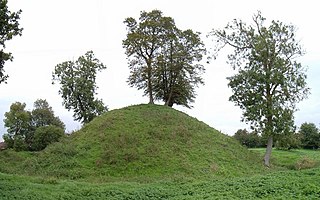
Longthorpe Tower is a 14th-century three-storey tower in the village of Longthorpe, famous for its well-preserved set of medieval murals.

Bowes Castle is a medieval castle in the village of Bowes in County Durham, England. Built within the perimeter of the former Roman fort of Lavatrae, on the Roman road that is now the A66, the early timber castle on the site was replaced by a more substantial stone structure between 1170 and 1174 on the orders of Henry II. A planned village was built alongside the castle. Bowes Castle withstood Scottish attack during the Great Revolt of 1173–74 but was successfully looted by rebels in 1322. The castle went into decline and was largely dismantled after the English Civil War. The ruins are now owned by English Heritage and run as a tourist attraction. There is free admission during daylight hours.

Kirby Sigston is a village and civil parish in the Hambleton district of North Yorkshire, England, approximately 4 miles (6.4 km) east of Northallerton. The village is situated on the Cod Beck river, and the wider parish contains the hamlet of Jeater Houses due east of the village on the trunk A19 road. The village is mentioned in the Domesday Book of 1086 as having 75 ploughlands, and its name derives from a combination of the Old Norse Kirkju-býr and Sigges tūn. Sigston is also the name of a village nearby.

Eye Castle is a motte and bailey medieval castle with a prominent Victorian addition in the town of Eye, Suffolk. Built shortly after the Norman conquest of England in 1066, the castle was sacked and largely destroyed in 1265. Sir Edward Kerrison built a stone house on the motte in 1844: the house later decayed into ruin, becoming known as Kerrison's Folly in subsequent years.

Totternhoe Castle was a Norman castle in Totternhoe. Bedfordshire. Only earthworks survive. It is a Scheduled Monument, and part of Totternhoe Knolls Site of Special Scientific Interest.
Bledisloe Tump was a castle in the village of Awre in Gloucestershire, England.

Castle Tump was a castle in the village of Dymock in Gloucestershire, England.

English Bicknor Castle was a castle in the village of English Bicknor in Gloucestershire, England.

Bishopton Castle was a medieval castle in Bishopton village, County Durham, England. The surviving motte is a Scheduled Ancient Monument.

Branthwaite Hall is pele tower in Cumbria, England, considered by historian Anthony Emery to be "one of the best-preserved early houses in Cumbria".

Drumburgh Castle is a medieval pele tower in the village of Drumburgh, in Cumbria, England.

Woodcroft Castle is a moated medieval castle in the parish of Etton, Cambridgeshire, England.

Stogursey Castle is a medieval castle in Somerset, England. Most of the site is in ruins, but there is a thatched gatehouse used for holiday rental by the Landmark Trust.

Thorpe Waterville Castle was a medieval fortified manor house near Thorpe Waterville, Northamptonshire, England.

Lidgate Castle is a medieval motte and bailey castle in the village of Lidgate, Suffolk, England, built to an unusual quadrangular design.

Newton St Loe Castle was a fortified manor house in the village of Newton St Loe, Somerset, England. Parts of it survive: a 14th-century keep and 15th-century gatehouse, both Grade I listed buildings.

Middleton Mount, also called Middleton Motte and Middleton Castle, is the remains of a medieval castle situated in the village of Middleton, in Norfolk, England.

Alnwick's town walls are a 15th-century defensive structure built around the town of Alnwick in England.
William Heron, Lord of Ford, was an English noble. He died in 1428 in a feud with the Manners family attacking their castle of Etal in Northumberland, England.


















